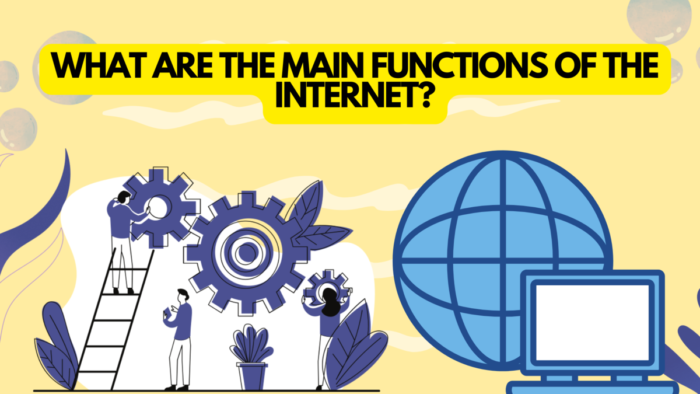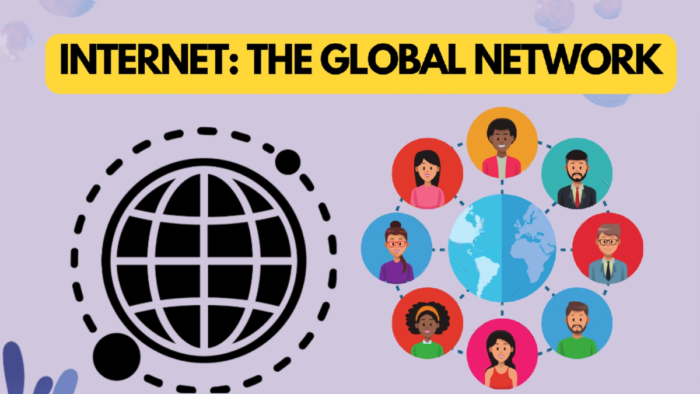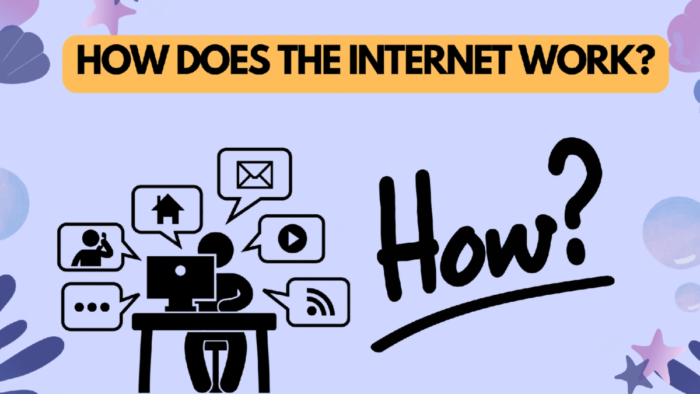The internet has become an indispensable part of our daily lives, connecting us with people and information from all over the world. From social media and online shopping to education and healthcare, the internet has transformed the way we live, work, and interact with one another. But have you ever stopped to think about what makes the internet work? What are the functions of the internet that allow us to access and share information so easily? In this article, we will explore the main functions of the internet, from data transmission and communication to online security and beyond. Whether you are a casual user or a tech enthusiast, understanding the functions of the internet can help you appreciate the complexity and importance of this global network.

THE FUNCTION OF THE INTERNET
The internet has become an essential part of our lives, and its functions are vast and varied. One of the most important functions of the internet is communication. The internet has revolutionized the way we communicate with each other, making it faster and more efficient. With email, instant messaging, and social media, we can now communicate with people all over the world in real-time. The internet has also made it easier to stay in touch with friends and family, even if they are on the other side of the world.
In addition to communication, the internet has also changed the way we access and share information. With just a few clicks, we can access a vast amount of information on any topic imaginable. The internet has made it possible for us to learn new things, research topics, and access news and information from anywhere in the world. The internet has also made it easier for us to share information with others, whether it be through social media, blogs, or online forums.
Another significant function of the internet is e-commerce. With the rise of online shopping, the internet has become a global marketplace, connecting buyers and sellers from all over the world. Online retailers can reach a much larger audience than traditional brick-and-mortar stores, and consumers can shop from the comfort of their own homes. The internet has also made it easier for small businesses to compete with larger companies, as they can now sell their products and services online.
Overall, the internet has revolutionized the way we communicate, access and share information, and conduct business. Its functions are vast and varied, and it continues to evolve and change every day. As the internet becomes more advanced and accessible, its impact on our lives will only continue to grow.
The worldwide web: connecting the world.

The internet is a global network of interconnected devices that enables the exchange of information and communication between individuals, businesses, and governments all over the world. Its function as a global network is one of its most important features. It allows people to connect with others who they may never have been able to communicate with before, breaking down geographical barriers and bringing people closer together.
The internet has made it possible for businesses to expand globally, connecting with customers and suppliers from all corners of the world. Companies can now operate in multiple countries simultaneously, and consumers have access to products and services from all over the world. This has led to increased competition, but it has also provided businesses with new opportunities for growth and development.
Governments also use the internet to communicate and exchange information with each other, which is essential for maintaining international relationships and partnerships. The internet has made it possible for people to connect with their governments, express their opinions, and participate in democratic processes from anywhere in the world.
The internet’s function as a global network has also led to the development of new technologies and innovations. For example, cloud computing, which allows users to access and store data and software over the internet, has transformed the way we store and access information. The Internet of Things (IoT) is another example, which involves connecting everyday devices such as home appliances and cars to the internet, enabling them to communicate and share data with each other.
What is the functioning of the internet?

The internet is a complex system of interconnected networks that enables the exchange of information and data between devices all over the world. Its function is to provide a way for computers and other devices to communicate with each other, allowing users to access information and services from anywhere in the world.
At its core, the internet is made up of servers and routers. Servers are powerful computers that store and manage data and services, while routers are devices that connect different networks together. When a user requests information or data from the internet, their device sends a request to a server, which then sends the requested information back to the user’s device.
The internet uses a system of protocols to ensure that data is transmitted and received correctly. One of the most important protocols is the Internet Protocol (IP), which is responsible for routing data packets between devices. Another important protocol is the Hypertext Transfer Protocol (HTTP), which is used to transfer data between servers and clients, such as web browsers.
The internet also relies on a system of domain names and IP addresses to identify and locate devices on the network. Domain names are easy-to-remember names that are associated with IP addresses, which are unique numerical identifiers assigned to every device on the internet. When a user types a domain name into their browser, the browser uses a system called the Domain Name System (DNS) to look up the IP address associated with the domain name.
The Internet Backbone
The internet backbone refers to the high-speed fiber-optic lines and routers that form the core of the internet infrastructure. These lines and routers are owned and maintained by various companies and organizations around the world and enable the functioning of the internet.
The backbone is responsible for transmitting data between different networks and devices, allowing users to access information and services from anywhere in the world. It also provides the high-speed connectivity necessary for applications like streaming video and online gaming.
The backbone is comprised of multiple interconnected networks that are constantly exchanging data packets with each other. These networks are connected by routers, which determine the best path for data packets to take as they travel across the internet.
One of the key features of the internet backbone is its redundancy. In order to ensure that the internet remains operational even in the event of a network failure, the backbone is designed with multiple backup routes and redundant connections. This means that if one network or connection fails, traffic can be automatically rerouted through another path.
The backbone is also constantly evolving and expanding to meet the growing demands of the internet. As more devices and users connect to the internet, the backbone must be upgraded and expanded to accommodate the increased traffic.
The Mechanics Of The Internet
The mechanics of the internet involve a complex system of technologies and protocols that enable the features of the internet that we use every day. Some of the key features of the internet include email, online shopping, social networking, video conferencing, and web browsing.
One of the foundational technologies that makes the internet possible is the TCP/IP protocol, which is responsible for routing data packets across the internet. This protocol breaks data into small packets and then sends them over the internet, where they are reassembled at their destination.
Another important technology that enables the internet is DNS, or the Domain Name System. DNS is responsible for translating human-readable domain names (like google.com) into IP addresses that computers can use to find and connect to websites and other internet resources.
The World Wide Web, which is often used interchangeably with the internet, is a system of interconnected documents and resources that are accessed through the internet. The web is based on the HTTP protocol, which is used to request and transmit web pages and other resources.
One of the most important features of the internet is its openness and decentralization. The internet was designed to be a decentralized network, which means that no single entity controls it. This makes it possible for anyone to create and publish content on the internet and for users to access that content from anywhere in the world.
The primary objective of the internet.
The intended purpose of the internet has evolved over time, but at its core, it was designed to be a network that would enable the sharing of information and resources between users and computers around the world. The internet was first created as a way for researchers and scientists to share data and collaborate on projects, but it quickly grew into something much bigger.
One of the key aspects of the internet’s intended purpose is its ability to democratize access to information. With the internet, anyone can create and publish content, and anyone with an internet connection can access that content from anywhere in the world. This has led to the rise of citizen journalism, online activism, and other movements that have given a voice to people who might not otherwise have been heard.
Another important aspect of the internet’s intended purpose is its role in facilitating communication and collaboration. The internet has made it possible for people from all over the world to connect with each other in real-time, regardless of geographic location. This has led to the rise of online communities and social networks, as well as new opportunities for remote work and collaboration.
In addition to its role in enabling communication and collaboration, the internet has also become a key driver of innovation and economic growth. The internet has enabled the development of new technologies and business models, from e-commerce to cloud computing to social media.
Overall, the intended purpose of the internet was to create a global network that would enable the sharing of information and resources between users and computers around the world. While the internet has evolved and grown beyond its original purpose, it continues to be a powerful tool for communication, collaboration, and innovation.
IoT (abbreviation for Internet of Things)
The Internet of Things (IoT) refers to the growing network of internet-connected devices that can communicate with each other and exchange data. These devices can range from simple sensors and smart home appliances to complex industrial machines and vehicles.
One of the key benefits of the IoT is its ability to collect and analyze data from a wide range of sources. By connecting everyday objects to the internet, we can gain new insights into how these objects are used, how they can be improved, and how they can be made more efficient.
In addition to data collection and analysis, the IoT has the potential to automate many aspects of our lives. For example, smart home devices can learn our preferences and adjust the temperature, lighting, and other settings accordingly. Industrial machines can be monitored and controlled remotely, reducing the need for human intervention.
However, the growth of the IoT also raises concerns around privacy and security. With more and more devices connected to the internet, there is a risk that personal information could be compromised or misused. There is also the potential for cyber attacks that could disrupt critical infrastructure or cause other harm.
Despite these challenges, the IoT is expected to continue to grow and evolve in the coming years. As more devices become connected, we can expect to see new innovations and use cases that will transform the way we live and work.
Frequently Asked Questions
What are the primary functions of the internet?
The primary functions of the internet are to facilitate communication, provide access to information, and allow for the transfer of data. This is achieved through a range of technologies and protocols that work together to connect devices and networks around the world.
In what way does the internet aid in the exchange of information between people and companies?
The internet allows individuals and businesses to communicate in a variety of ways, such as email, instant messaging, voice and video calls, and social media. These communication channels are enabled by various applications and protocols, such as SMTP (Simple Mail Transfer Protocol) for email and SIP (Session Initiation Protocol) for voice and video calls.
How does the internet’s security features safeguard my data?
The security functions of the internet include encryption, firewalls, antivirus software, and other technologies that protect against cyber threats. Encryption, in particular, is used to secure data in transit and at rest, by encoding it in such a way that only authorized parties can access it. Firewalls and antivirus software help prevent unauthorized access and block malicious code from infecting your devices.
Could you elaborate on how the internet plays a part in e-commerce and the act of shopping online?
The internet has revolutionized e-commerce and online shopping, by providing a platform for businesses to sell their products and services to a global audience. The internet enables businesses to reach customers through websites, social media, and online marketplaces, and to accept payments securely through a range of digital payment options.






You must be logged in to post a comment.